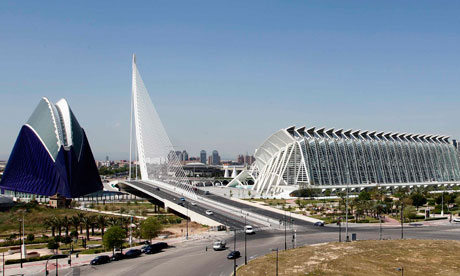 |
| The Stock Exchange, before demolition |
He was, perhaps, a star architect of his era.
His buildings were constructed from the inside out, to make usable spaces that were also beautiful on the outside. Times and tastes changed, however, and he ended up designing little boxes for banks in small towns in the American middle west.
What did not change was his motto, that form follows function. He thought that buildings should work for those inside, and from there the architect could design a facade that made the structure attractive to those outside.
That was then, in another era, when buildings were decorated with elaborate terra cotta and cast iron motifs that reflected the prairie from which Chicago rose.
Today's starchitects are all about the facade, about making sculptures that attract attention and bring in the commissions from those who would like to put their name on a building that reflects some attention back on them.
 |
| The Valencia skyline |
Bogged down in debt, the taxpayers of Valencia are asking why their leaders thought it was a good idea to borrow heavily to build Mr. Calatrava's City of the Arts and Science. The project is so far over budget that the budget seems more like a fairy tale than real numbers, and there is no indication that the buildings are going to improve the financial picture of Valencia.
The architect earned a considerable amount of money, as you'd expect. He's a star.
What the people have ended up with are buildings that don't work. The form doesn't allow for the function. It's just a form that doesn't look like anything else that's been done before, but looks aren't everything.
One critic has pointed out that someone earning millions of euro in salary should not have forgotten to include elevators and fire escapes in a science museum. Those are just basic necessities. Even Louis Sullivan managed the elevator business, down to the exquisite doors that fronted them.
Windows leak. Several seats at the opera house are behind pillars, where the lack of a view to the stage would require some pretty steep discounts on the seat price. You don't recoup costs very quickly if you can't charge full price.
It is one thing to create works of art to be admired from many angles. It is quite another to try to cram a building into a work of art and then tell everyone that the structure will work just fine for its intended purpose.
That takes hubris. Which is what you'd expect to find in a star architect who commands millions of euro in commissions.
Form used to follow function. Today's big name architects have forgotten the old lessons in a rush to make something new and make a big name. Unfortunately for the taxpayers paying for the public buildings designed by the starchitects, they need the function more than the form.
No comments:
Post a Comment